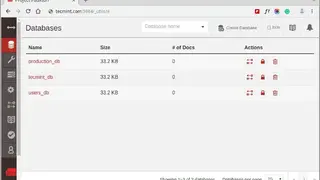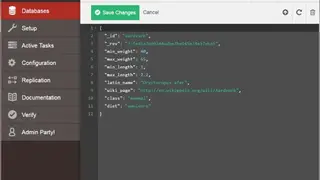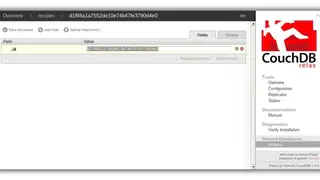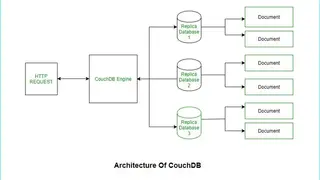
Apache CouchDB
Apache CouchDB is an open-source NoSQL database that focuses on ease of use. It stores JSON to store data, HTTP for its API, and by using MapReduce, it uses JavaScript as its query language. One of the outstanding features of Apache CouchDB is that it provides multi-master replication that lets you access the data where you need it. This replication protocol allows your data to flow uninterrupted between servers to mobile phones and web browsers. This enables an offline-first experience which increases browsing speed with slow internet.
All the applications stored on your own servers are supported by Apache CouchDB as it is built on JSON and binary data. The clustered database lets you run a single logical database server on multiple virtual machines. Apache CouchDB can be installed on small projects from Raspberry Pi to big cloud installations. It is available for Windows, macOS, and Ubuntu OS. The source code is also available to download.
The data stored in Apache CouchDB is structured using no. of views. Every view is considered by a JavaScript function, which transforms the document into a single value that it returns. This view is then used as an index to check whether the file is updated, added, or removed.
Apache CouchDB Alternatives
#1 Redis
Redis is an open-source and in-memory store software that prevents the duplication of data and that requests to external sources. This software is a remote dictionary server that lets robust, open-source, in-memory key-value data store to use as a database, message broker, cache, and queue. Redis comes with optional durability to implement a distributed, key-value database, and it permits different kinds of data structures, including lists, maps, sorted sets, bitmaps, indexes, and more.
It has different commands such as append to add value to key, Bitcount to count sets in strings, Bifield to perform arbitrary integer operation, Bipos to find the first-bit set, Brpop to remove and get the last element in a list, client id to return id in the current location, and many such commands included. This software has many advanced modules that are neural-redis for neural networks, rediSearch for full-text, Redis graph for space adjacency matrices, session gate for multiple payloads, and many modules to add.
#2 MongoDB
MongoDB is a free and open-source cross-platform document database that leverages the innovations of NoSQL and thrives on the spine of durable consistency and relationship databases that includes secondary indexes and expressive query languages. It is the best way to deploy, operate, and scale MongoDB in the cloud.
Its real-time aggregation, indexing, and ad hoc query present unique techniques to access and analyze organization data. The solution helps you to accelerate time to value and reduce the risk involved in mission-critical deployments. It is a robust platform that is published under the GNU General Public License and is supplied as free, open-source software.
MongoDB is also known as one of the best IT management solutions that creates the best relational with the innovation of NoSQL. The program includes core features such as high scalability and performance, REST-like API, declarative data access control, durable consistency, and much more. Overall, MongoDB is one of the best databases as a service as compared to others.
#3 Couchbase Server
Couchbase Server is a NoSQL cloud database server. It is one of the most versatile and scalable databases that can be deployed on-premises or on the cloud. Features that make Couchbase Server faster than its alternatives are Flexible JSON schema for continuous delivery, SQL friendly, an easy query language for JSON, Integrated software development kits from Java, Scala, .NET, GO, JavaScript, and Python. It can also do peer-to-peer cloud synchronization for edge or mobile computing.
Couchbase Server architecture is built in a way to give you a scaleable database anywhere. Built on Memory-first design for high performance. Additionally, ACID transactions, asynchronous clustering, masterless clustering, and geo-aware clustering are also available. An outstanding feature is a native replication that combines with distributed cloud architecture to guarantees all-time availability.
Save ownership cost by managing distributed clusters from one single console that you can scale and fine-tune the Couchbase Server to match your Virtual Private Cloud Server. Other features are Eventing for real-time change in data, Multi-dimensional Scaling, Queries, analytics, and Enterprise-Grade security.
#4 Cosmos DB
Cosmos DB is a NoSQL database server for modern app development. It focuses on speed and response time that could be as low as one millisecond. Cosmos DB provides much faster and productive app development thanks to ready-to-use multi-region data distribution, APIs, and SDKs for popular languages, including .NET, Python, Node.js, and Java. It is deeply integrated with Azure’s key services that are used in cloud app development.
Major benefits of using Cosmos DB are real-time data access with fast read/write latencies, Multi-region writes and distribution, Elastically scalable storage that ensures availability even in case of unpredictable traffic bursts. You can run your most demanding applications in any Azure region with SLA-backed speed. With multi-master replication and enterprise-grade compliance, your data is end-to-end encrypted. Other features are NO-ETL analytics over real-time data, Real-time loT device Telemetry, Hybrid Platform for Cassandra data, and real-time retail service.
#5 OrientDB
OrientDB is an open-source NoSQL database management system that is written in Java. It is more advanced than its alternatives as it includes a Multi-model database, support graphs, object models, document, and key/value. Schema-less, Scheam mixed, and Schema-full modes. Based on user roles and support queries, the profiling system is very secure. Features of OrientDB are, Full ACID support for transactions for seamless recovery of data in case of any crash, graph-structured data model for native management of graphs, SQL queries support with extensions to handle relationships, manage trees, and documented graphs.
It natively supports RESTful, HTTP, JSON, and other libraries. Just like pothers, it also supports multi-master replication, including geo-distributed clusters. The server has a footprint of 512 KB that comes with an Apache 2 license to ensure no royalty fees and commercial support. The extensible framework adds authenticators, password validation, import of user roles database, LDAP, advance auditing, and Syslog support to its security. All in all, the service is best suited for those who want to deploy a large database into the cloud.
#6 ArangoDB
ArangoDB is an open-source, multi-model, and NoSQL database system. It supports three data modes, i.e., documents, key/value, and graphs. Built with Arango Query Language (AQL), the language is declarative and allows the different combinations of data access patterns in a single query. ArangoDB features include scaleable queries while working with graph data, JSON file format as a default storage format, and VelocityPack binary format for storage and sterilization.
It works in a distributed cluster, and it’s one of the first databases to be called DC/OS (Datacenter Operating System). DC/OS lets you deploy ArangoDB on existing systems like Amazon Web Services, Google Compute Engine, and Microsoft Azure. Single-click deployment from the single-user cluster is also supported.
With the combination of JSON stores, graph technology, and semantic search, it is often used to provide active storage for accessing data. Eventually, the ArangoDB is made for Data Scientists, Developers, and Architects.
#7 Apache Cassandra
Cassandra or Apache Cassandra is a free and open-source distributed wide column store NoSQL database management system specially designed to handle huge amounts of data across multiple commodity servers. It provides high availability with no single point of failure. It offers robust support for clusters spanning multiple datacenters with asynchronous master-less replication that allows low latency operation for all clients.
It is a complete and powerful solution with all the major database management tools for organizations across multiple industries with large data sets that constantly change. The most prominent features include distributed, support replication and multi-data centre replication, scalability, map-reduce support, query language, and much more. Try it out; it is one of the best Database management solutions compared to the others.
#8 Neo4j
Neo4j is a reputable platform that is dispensing graph database management services and is a compliant transactional database with native graph storage and processing. It is one of the best graph management software in DB-engine ranking provided you with the most efficient databases. Neo4j used property graphs that aid in extracting the added value of data of any company in a flexible and scalable way and has a better performance than any other relational and non-relational databases.
The software is making its mark in empowering mission-critical enterprise applications that are fraud detection, artificial intelligence, social networking, and many others. There are multiple features offered by Neo4j that are graph expertise to shorten the learning curve, open-source graph innovators, graph algorithms, Neo4j sandbox, advanced management of the data. The software is a flexible solution for the organization to take a step in active graph learning that boost up their productivity.
#9 Oracle Database
Oracle Database is a collection of a database designed to use with Oracle software. The whole data is treated as a single unit, and information can be retrieved from it when needed. It prevents an efficient solution to failure recovery and prevents unauthorized access.
This database has separate logical and physical structures, and both can be managed without affecting one another. The solution is a cross-platform that can run over different operating systems. The networking stack allows other applications to communicate directly with the Oracle Database. Memory cashing, Data Dictionary, Backup and recovery, clustering, and partitioning of the database are some of the popular features of the platform. With the help of its tools, databases can be toned, and performance can be improved. Furthermore, the graphic tools of the platform are easy to use and do all the work.
SQL programming language is required to access the platform. The cloud feature of the database provides Autonomous transaction processing and data warehouse. Moreover, machine learning, security, high availability, and application development are some of the features provided by the platform. Oracle Database has three editions – Expression, Standard, and Enterprise. The service has online and 24/7 live support.
#10 Microsoft Office Access
Microsoft Office Access is presently a great deal more than an approach to make desktop databases. It’s a simple to-utilize instrument for rapidly making program based database applications that help you maintain your business. Your information is naturally put away in an SQL database, so it’s more secure than any other time in recent memory, and you can without much of a stretch impart your applications to partners.
Effortlessly begin by making a custom application or get enlivened by an accumulation of new and professionally-planned application layouts. With Access Services and SharePoint Online or on-premises SharePoint Server 2013, Access applications can now be effectively overseen and observed through an organization SharePoint website in a program.
It empowers multi-client availability, and the consents control anticipated from SharePoint alongside permeability on application utilization. The backend has been moved to SQL Server and Microsoft Azure SQL Database to take into account.
Get to applications now influence standard SQL linguistic structure and a genuine mission-basic back end, whether sent on-premises or in the cloud. Utilizing SQL Server and Azure SQL databases to store its information, Microsoft Access unites the designers of the instrument need to construct convincing and hearty database applications. Its ability to associate information sets put away in various sources, together with the liberal arrangement of expert devices for overseeing complex databases, is the thing that makes it one of the main information administration items out there.
#11 LibreOffice Base
LibreOffice Base is an open-source database management tool. It is a LibreOffice suite-based tool that can be used across multiple platforms. This tool allows its users to get complete access to their database along with some additional functionalities like database creation, modification, and database access. The best part about this tool is its attractive GUI that allows users to complete all the above-mentioned tasks with ease.
Furthermore, this platform also includes tools like forms, queries, reports, tables, and wizard guide. To make this platform operational user then further requires Java Runtime Environment. Furthermore, LibreOffice Base is known to be compatible with both built-in and outside databases so that users get complete freedom of use.
#12 Brilliant Database
Brilliant Database is software that lets you create a database without even the requirement of technical skills. This platform includes different tasks like reports, scripts, database design, formulas, form, and other similar files. This platform features a report, visual form, mathematical formulas, script editor, etc. Each of these editors included in it have different functions like for form editor, few tools are added for forms creation like fonts, color, style, and other requirements that you would require.
Similarly, as for the formulas calculator, different standards are constructed at the back end to provide you an exact and detailed solution for any mathematical problem. As for script designer, you do not require any technical skills because there is a wizard added to it, which will help you out throughout the process.
#13 Microsoft SQL Server
Microsoft SQL Server is a database management platform which is developed by published by Microsoft Inc. It is a database server that features to store and retrieve any user data which is requested at its main interface. The data stored here can be access from the admin or any other PC using this service with the help of an Internet connection.
There are multiple versions released for this platform depending on the user’s requirement or the business of data they are going to store here. All the process involved on this platform requires a specific format such as TDS or Tabular Data Stream. It is an application layer protocol used to send or receive data between multiple servers or clients.
#14 Firebird
Firebird is an open-source social database framework that can be sent on different platforms, giving a beginning stage to create complex database applications. This bundle includes a grouping of the server, advancement and management devices, and also customer segments that cooperate with a specific end goal to give a durable yet flexible alternative to the extent of database administration.
Its exchange administration and inquiry execution against different databases will undoubtedly facilitate your work when managing numerous databases. You can pick between Firebird.NET, Java, Delphi/C++, Lazarus, FreePascal, FireRuby, PHP, Python, and Perl. Firebird’s ongoing observing and information logging abilities permit on-the-spot investigating of SQL code and remote inspecting.
#15 SQLyog
SQLyong is an ultimate tool that lets admins, architects, and developers optimize and compare different schemas. It is an automated tool that synchronizes the complete data between multiple MySQL hosts. This tool does not require any installation and can run on any host available. It is the best source for comparing data from different sources before starting any process.
All you need to do is run this tool in the attended mode and start comparing host and target. The best part about it is that you can visualize the complete process and then develop a schema according to your requirements. It can also let you back up the files on the scheduled timeline.
#16 My Visual Database
My Visual Database is a basic advancement environment database. With this, you will be able to make a Windows application database without authorities and programming abilities. It can be a basic phone registry and bookkeeping framework in your business. Do you require a database application without excess? Well, with this tool, you can make it yourself without the assistance of experts and programming aptitudes. Make a full useful UI in minutes without composing any code. The consequence of your plan will be an undeniable Windows application, prepared to deal with any PC.
Utilizing My Visual Database, you can make different databases, from minor phone indexes to complex frameworks. You will have the capacity to disseminate it among partners. The application will be exhibited under your name and logo. Thinking about its convenience and the primary elements that it accompanies, it furnishes you with an improved visual environment that empowers you to tweak and control databases, tables, and structures the way you need.
#17 Apache OpenOffice Base
Apache OpenOffice Base is a completely highlighted desktop database administration framework intended to address the issues of a wide cluster of clients, from following individual CD accumulations to delivering corporate month-to-month departmental deals reports. It offers wizards to help clients new to database outline for making tables, queries, forms, and reports, alongside an arrangement of predefined table definitions for following assets, customers, sales orders, invoices, and a great deal more.
When an individual uses this tool, a database is all they require. It offers the full HSQL social database motor, designed for a single client. It supports JDBC and ODBC standard drivers that permit users to interface with substantially any database. It is productive and dependable programming that includes all the fundamental instruments to end your decision’s office suite.
#18 Symphytum
Symphytum is an individual database programming for everybody who wants to oversee and sort out information without studying complex database and programming UIs. This database lets you utilize content, numbers, pictures, documents, and other control fields. It puts your information in the cloud for automatic synchronization on every single one of your PCs.
This tool lets you use the frame to see organized information, representation and utilize the table-like view for sorting and contrasting. Drivers for cloud administrations, for example, Dropbox, are incorporated. The best part about this database is that it leaves behind all those complex databases and complicated UIs. Instead, it provides an understandable user interface with completely guided features.
#19 Alpha Five
Alpha Five is a low-code, fast application advancement and organization environment for building local quality, cross-stage web, and versatile business applications. Using this tool, clients of all expertise levels can rapidly get to make versatile business structures and applications that keep running over all gadgets. Its database permits you to grow effective redid desktop & WEB applications quickly and effortlessly. It is a valuable and complex database tool where no programming is required. Non-developers now can make desktop and web database applications without figuring out how to code.
Engineers can significantly cut advancement time and spare cash by making web database applications in a small amount of time instead of programming in ASP, PHP, or Perl. Alpha Five’s inventive application scripting and web segments permit you to control your data and make you independent regarding the capacity to assemble modern applications for your specific business or association on the desktop and the web.
#20 Kexi
Kexi is a visual database applications maker. It is used for making database patterns, embedding information, performing inquiries, and handling information. Structures can be made to give a custom interface to your information. All database objects – tables, inquiries, and structures – are put away in the database, making it simple to share information and plan. It is considered an anticipated open-source contender for Microsoft Access, FileMaker, and Oracle Forms.
It is a convenient and cross-stage application that backs all GNU/Linux appropriations. It was effectively tried on Ubuntu, Arch Linux, Debian, openSUSE, Fedora, Red Hat Enterprise Linux, CentOS, Mageia, Linux Mint, and other well-known distribution of software. Kexi is not a standalone application. You need to download it just as a major aspect of the Calligra office suite, which can be effectively introduced on any previously mentioned Linux distribution.
#21 MySQL
MySQL is an amazing programming application, so its establishment and setup require a fine measurement of database and server information. This tool comes in two different versions that are standard and definite, which is a more progressed and ideal approach to sending the server.
There is no GUI to MySQL, yet you can play out all the database operations and tools available. One of its fast proposals is Oracle’s MySQL Workbench. On the end note, it remains a high degree, valuable and successful arrangement in programming. It also includes few other fundamental bundles, such as Apache and PHP, it can be an answer for building overwhelming designs, such as content administration frameworks or blog stages.

























